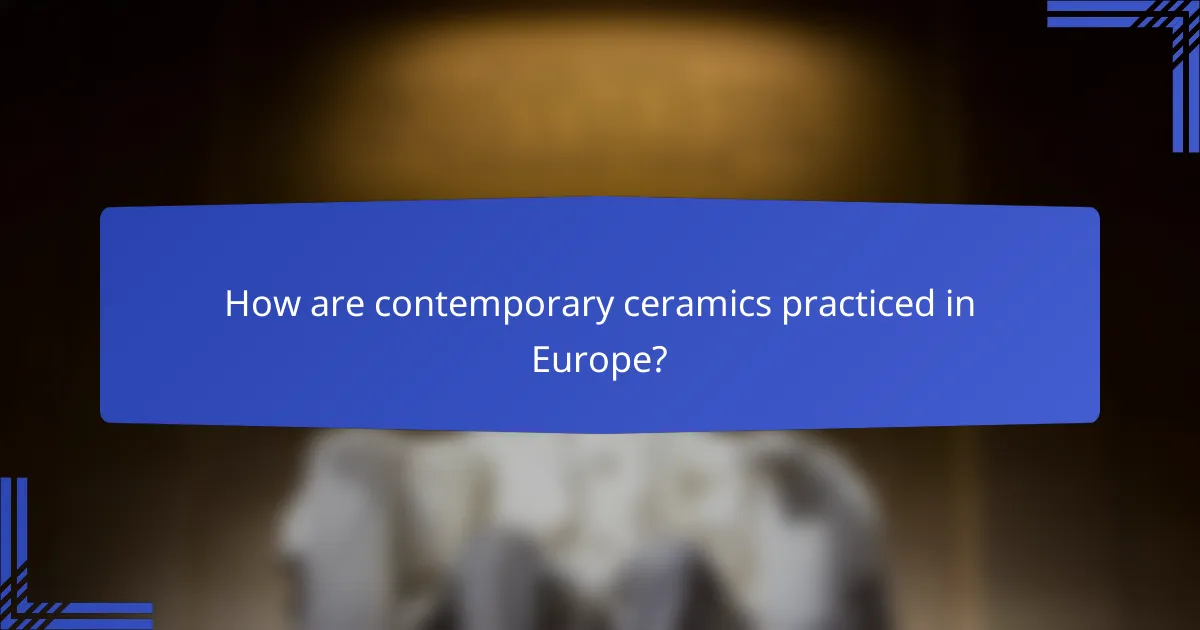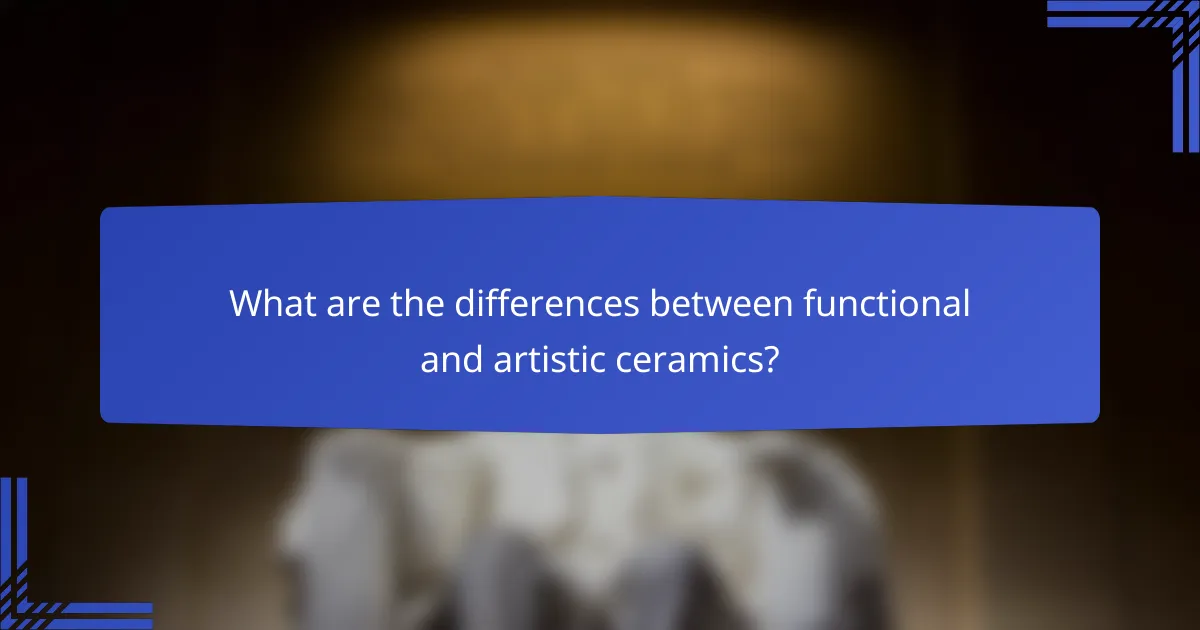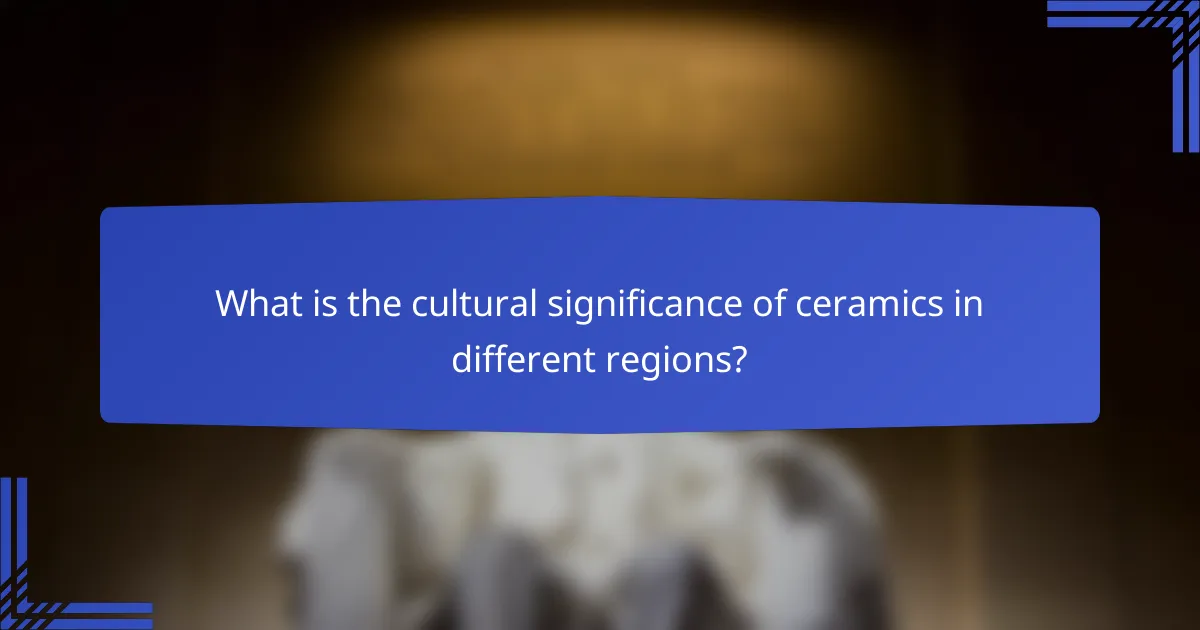Contemporary ceramics represent a dynamic intersection of traditional craftsmanship and modern innovation, showcasing both functional and artistic expressions. While functional ceramics serve practical purposes like dinnerware, artistic ceramics prioritize aesthetics and personal expression, often reflecting cultural narratives and community identities. Understanding these distinctions enhances appreciation for the diverse roles ceramics play in our lives and cultures.

How are contemporary ceramics practiced in Europe?
Contemporary ceramics in Europe blend traditional craftsmanship with modern innovation, emphasizing both functional and artistic expressions. Artists and potters utilize diverse techniques and materials, reflecting cultural narratives and personal stories through their work.
Innovative techniques in studio pottery
Studio pottery in Europe has seen a surge in innovative techniques, such as alternative firing methods like raku and pit firing. These processes create unique surface textures and colors, enhancing the aesthetic appeal of functional pieces.
Many contemporary potters experiment with mixed media, incorporating materials like glass or metal into their ceramic works. This fusion not only expands the visual language of ceramics but also challenges traditional notions of pottery.
Integration of technology in ceramic art
Technology plays a significant role in contemporary ceramic practices, with artists using digital tools for design and production. 3D printing, for example, allows for intricate shapes and patterns that would be challenging to achieve by hand.
Moreover, software programs enable potters to visualize their designs before creating them, streamlining the creative process. This integration of technology can enhance precision and open new avenues for artistic exploration.
Collaboration with designers and architects
Collaborations between ceramic artists and designers or architects are increasingly common in Europe, resulting in innovative functional art pieces. These partnerships often lead to unique installations that blend ceramics with architecture, enhancing public spaces.
Such collaborations can also involve creating bespoke items for interior design projects, where ceramics serve both aesthetic and practical purposes. This synergy not only elevates the status of ceramics but also fosters a greater appreciation for the craft in contemporary design contexts.

What are the differences between functional and artistic ceramics?
Functional ceramics are designed for practical use, such as dinnerware or cookware, while artistic ceramics focus on aesthetics and expression, often serving as decorative pieces. Understanding these differences can help in selecting ceramics that meet specific needs or preferences.
Functional ceramics in daily use
Functional ceramics include items like plates, bowls, mugs, and vases that serve everyday purposes. These pieces are typically crafted to withstand heat and wear, making them suitable for cooking and serving food. Common materials used include stoneware, porcelain, and earthenware, each offering varying durability and aesthetic qualities.
When choosing functional ceramics, consider factors such as microwave and dishwasher safety, as well as the weight and balance of the pieces. For example, stoneware is often more chip-resistant than porcelain, making it a practical choice for daily use.
Artistic ceramics as collectible pieces
Artistic ceramics are primarily created for visual appeal and often reflect the artist’s style or cultural heritage. These pieces can include sculptures, decorative bowls, and unique installations, typically made with a focus on craftsmanship and design rather than utility. Collectors often seek out these items for their beauty and the stories they tell.
When investing in artistic ceramics, consider the artist’s reputation, the uniqueness of the piece, and its condition. Limited editions or works by well-known artists can appreciate significantly in value over time. Additionally, ensure proper care and display to maintain the integrity of these collectible items.

What is the cultural significance of ceramics in different regions?
Ceramics hold deep cultural significance across various regions, serving both functional and artistic purposes. They reflect local traditions, craftsmanship, and social values, often embodying the identity of communities.
Historical context in Asian ceramics
Asian ceramics, particularly from countries like China, Japan, and Korea, have a rich history that dates back thousands of years. These ceramics often showcase intricate designs and techniques, such as celadon and porcelain, which were developed and perfected over centuries.
In China, ceramics were not only utilitarian but also symbols of status and artistry, with dynasties like the Tang and Ming producing renowned pieces that are highly sought after today. Japanese ceramics, influenced by Zen philosophy, emphasize simplicity and natural beauty, evident in styles like Raku and Shino.
Modern interpretations in Western art
In the West, contemporary ceramics have evolved to blend functionality with artistic expression. Artists often experiment with form, color, and texture, creating pieces that challenge traditional notions of pottery. This shift has led to a resurgence in interest in ceramics as a medium for fine art.
Modern ceramicists may draw inspiration from historical techniques while incorporating modern aesthetics, resulting in unique works that can be both decorative and functional. Galleries and exhibitions increasingly showcase these innovative pieces, highlighting the ongoing dialogue between tradition and contemporary practice.

What are the key considerations when selecting ceramics for home decor?
When selecting ceramics for home decor, consider factors such as material quality, durability, and design aesthetics that align with your personal style. These elements will ensure that your ceramic pieces not only enhance your space but also stand the test of time.
Material quality and durability
Material quality is crucial when choosing ceramics, as it affects both the longevity and functionality of the pieces. Look for ceramics made from high-fired stoneware or porcelain, which are generally more durable than earthenware. Check for any visible cracks or imperfections that may compromise the integrity of the item.
Additionally, consider the intended use of the ceramics. If they will be used for serving food, ensure they are food-safe and resistant to chipping. For decorative pieces, prioritize those that can withstand temperature changes and are less prone to fading over time.
Design aesthetics and personal style
Design aesthetics play a significant role in how ceramics fit into your home decor. Choose pieces that complement your existing color scheme and furnishings. For instance, minimalist designs may suit modern interiors, while intricate patterns might be better for traditional settings.
Personal style should guide your selection process. Consider whether you prefer bold statement pieces or subtle accents. Mixing different styles can create visual interest, but ensure that the overall look remains cohesive. A good rule of thumb is to select ceramics that resonate with your taste while also enhancing the ambiance of your space.

How do ceramics influence sustainability practices?
Ceramics play a significant role in promoting sustainability practices by utilizing eco-friendly materials and minimizing waste during production. These practices not only reduce environmental impact but also encourage a shift towards more responsible consumption in the ceramics industry.
Use of eco-friendly materials
Utilizing eco-friendly materials in ceramics involves selecting sustainable clays, glazes, and additives that have lower environmental footprints. For instance, natural clay sources and non-toxic glazes can significantly reduce harmful emissions during firing processes.
Artists and manufacturers can also explore recycled materials, such as repurposed glass or reclaimed clay, to create unique pieces while conserving resources. This approach not only enhances the aesthetic value of the ceramics but also aligns with sustainable practices.
Reduction of waste in production
Reducing waste in ceramic production can be achieved through efficient design and careful planning. Techniques such as slip casting and 3D printing allow for precise material usage, minimizing excess waste. Additionally, recycling scrap clay and glaze can further decrease the amount of material discarded.
Implementing a closed-loop system, where waste materials are reused in the production cycle, can also enhance sustainability. By adopting these methods, ceramic artists and manufacturers can significantly lower their environmental impact while maintaining high-quality outputs.

What are the emerging trends in ceramic art?
Emerging trends in ceramic art reflect a blend of traditional techniques and innovative practices, emphasizing both functionality and artistic expression. Artists are increasingly exploring new materials, technologies, and cultural narratives, resulting in diverse and dynamic works that challenge conventional boundaries.
Use of mixed media in ceramics
The integration of mixed media in ceramics allows artists to combine various materials such as glass, metal, and textiles with clay. This approach enhances the visual and tactile qualities of ceramic pieces, creating unique artworks that engage multiple senses. For instance, incorporating LED lights or found objects can transform a simple ceramic vessel into a captivating installation.
When working with mixed media, consider the compatibility of materials during firing and the overall aesthetic coherence of the piece. Artists should experiment with different combinations to discover what resonates best with their vision while ensuring structural integrity.
Global influences on local practices
Global influences are reshaping local ceramic practices, as artists draw inspiration from diverse cultures and traditions. This cross-pollination of ideas often leads to innovative techniques and styles, merging local craftsmanship with international trends. For example, a potter in Europe might incorporate Japanese glazing techniques while using local clay sources.
To effectively navigate these influences, artists should remain aware of their cultural context and the stories they wish to convey. Engaging with global trends can enrich local practices, but it is essential to maintain authenticity and respect for the origins of the techniques being adapted.

How can one get involved in the ceramics community?
Getting involved in the ceramics community can be achieved through various avenues, including local classes and exhibitions. Engaging with these activities allows individuals to connect with fellow enthusiasts and enhance their skills.
Joining local pottery classes
Local pottery classes are a great starting point for anyone interested in ceramics. These classes typically range from beginner to advanced levels, allowing participants to learn techniques such as hand-building, wheel throwing, and glazing.
When selecting a class, consider factors like location, class size, and instructor experience. Many studios offer flexible schedules, including evening and weekend options, making it easier to fit into your routine.
To find classes, check community centers, art schools, or dedicated pottery studios. Some may even offer trial sessions, so you can gauge your interest before committing.
Participating in ceramic exhibitions
Participating in ceramic exhibitions provides an opportunity to showcase your work and connect with other artists. These events can range from local fairs to larger, juried exhibitions, which often feature a variety of ceramic styles and techniques.
To get involved, research upcoming exhibitions in your area and review their submission guidelines. Many exhibitions have specific themes or categories, so ensure your work aligns with their criteria. Additionally, consider volunteering at these events to gain insights and network with other ceramicists.
Exhibitions not only allow you to display your creations but also to receive feedback and inspiration from peers and visitors, enriching your artistic journey.
